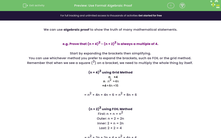We can use algebraic proof to show the truth of many mathematical statements.
e.g. Prove that (n + 4)2 - (n + 2)2 is always a multiple of 4.
Start by expanding the brackets then simplifying.
You can use whichever method you prefer to expand the brackets, such as FOIL or the grid method.
Remember that when we see a square (2) on a bracket, we need to multiply the whole thing by itself.
(n + 4)2 using Grid Method
| n | +4 | |
| n | n2 | +4n |
| +4 | +4n | +16 |
= n2 + 4n + 4n + 6 = n2 + 8n + 6
(n + 2)2 using FOIL Method
First: n × n = n2
Outer: n × 2 = 2n
Inner: 2 × n = 2n
Last: 2 × 2 = 4
= n2 + 2n + 2n + 4 = n2 + 4n + 4
n2 + 4n + 4n +16 - (n2 +2n + 2n + 4)
= n2 + 4n + 4n + 16 - n2 - 2n - 2n - 4
= 4n + 12
Then we need to factorise to show that 4 is a factor and that the expression is a multiple of 4:
4(n + 3)
We use a set of expression to show different kinds of numbers.
These help us with writing algebraic proofs:
| 2n | an even number |
| 2n + 1 | an odd number |
| n, n+1, n+2 | consecutive numbers |
| 2n, 2n+2, 2n+4 | consecutive even numbers |
| 2n+1, 2n+3, 2n+5 | consecutive odd numbers |
| 6n | multiple of 6 |
| 5n | multiple of 5 |
Have a look at this question now.
e.g. Prove that the sum of any three consecutive even numbers is always a multiple of 6.
Sum means adding.
We are going to show that adding three consecutive even numbers (2n, 2n+2, 2n+4) gives a multiple of 6:
2n + 2n + 2 + 2n + 4
Simplify:
6n + 6
Factorise to show 6 is a factor:
6(n + 1)
In this activity, we will learn more about how to express mathematical proofs and the features of formal algebraic proof which you need to be familiar with using.
You may want to have a pen and paper handy to record your working, as some of these proofs can become quite complex.







